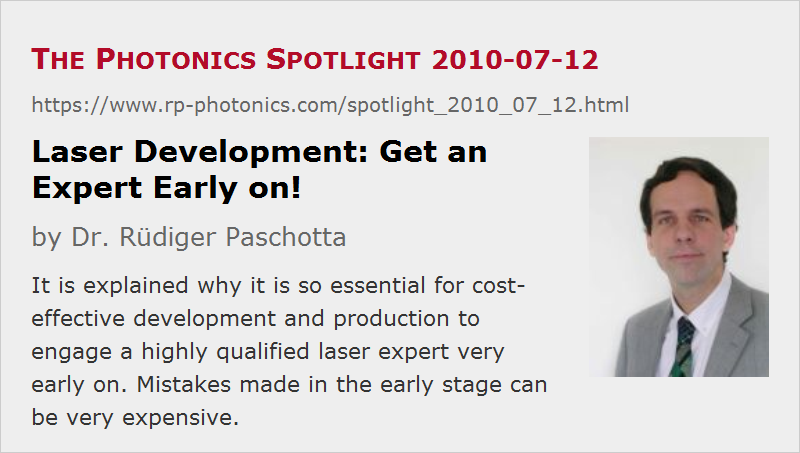Laser Development: Get an Expert Early on!
Posted on 2010-07-12 as a part of the Photonics Spotlight (available as e-mail newsletter!)
Permanent link: https://www.rp-photonics.com/spotlight_2010_07_12.html
Author: Dr. Rüdiger Paschotta, RP Photonics Consulting GmbH
Abstract: It is explained why it is so essential for cost-effective development and production to engage a highly qualified laser expert very early on. Mistakes made in the early stage can be very expensive.
Ref.: encyclopedia articles on laser development and laser design

Too often I encounter cases where a customer reports serious problems with a laser development project or even later on during production, and where I find out that serious mistakes have been done in an early stage. The problem is not to analyze the mistakes later on – spending just a few hours on a project, I can often work out exactly what has gone wrong. The trouble is that important decisions have already been taken, and it is very expensive for the customer to repair their effects. At least, a substantial amount of resources has already been spent for failed attempts, and obviously I cannot undo this when being called in only later on.
I wonder why people often fall into such traps. Apparently, they often do not recognize in the early phase that sufficient know-how is not available in the team. (Note that it requires some know-how to recognize missing know-how!) For example, they have got a prototype which more or less does what they want, and do not appreciate that it may take quite some work to move from such a prototype to something which you can manufacture and deliver to the end customer without problems.
In my most recent case, a customer ordered some specialized small company to develop a prototype for a fiber amplifier system, and then licensed this technology. Later on, it turned out that a substantial fraction of the devices produced did not meet the specifications due to random fluctuations of component parameters. The dependence on such fluctuations was rather high, because the amplifier was not operated in the fully saturated regime; you then get some exponential dependencies. I consider this as a flaw of the design, not just bad luck, and would have located and solved this problem if I had been involved at this stage. However, my customer believed at that time that everything was fine, and trusted the fiber amplifier company to have sufficient know-how for that job. This is understandable in a way, but it also shows that it can be extremely valuable in such cases to call in a second opinion from a laser expert with a lot of know-how and experience.
Obviously, it does not hurt to spend a few thousand dollars more in the very early phase in order to avoid problems which can easily cost you 100 times more money and time later on. Those who have experienced that will certainly not worry about my hourly rate in their next project, but make sure that I will be involved at the earliest possible stage.
This article is a posting of the Photonics Spotlight, authored by Dr. Rüdiger Paschotta. You may link to this page and cite it, because its location is permanent. See also the RP Photonics Encyclopedia.
Note that you can also receive the articles in the form of a newsletter or with an RSS feed.
Questions and Comments from Users
Here you can submit questions and comments. As far as they get accepted by the author, they will appear above this paragraph together with the author’s answer. The author will decide on acceptance based on certain criteria. Essentially, the issue must be of sufficiently broad interest.
Please do not enter personal data here; we would otherwise delete it soon. (See also our privacy declaration.) If you wish to receive personal feedback or consultancy from the author, please contact him e.g. via e-mail.
By submitting the information, you give your consent to the potential publication of your inputs on our website according to our rules. (If you later retract your consent, we will delete those inputs.) As your inputs are first reviewed by the author, they may be published with some delay.
 |




If you like this page, please share the link with your friends and colleagues, e.g. via social media:
These sharing buttons are implemented in a privacy-friendly way!